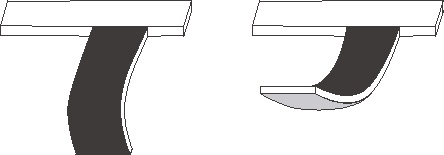
Compressive and tensile stress
Adsorption of molecules on the upper (functionalized) surface will result in a downward bending of the microcantilever due to the formation of surface stress. Surface stress is called ‘compressive’ (see Fig., left), because the adsorbed layer of molecules (e.g. a monolayer of alkylthiols) produces a downward bending of the microcantilever away from its functionalized side. If the opposite situation occurs, i.e. when the microcantilever bends upwards, we would speak of ‘tensile stress’ (see Fig, right). If both the upper and the lower surface of the microcantilever are exposed to surface stress changes, then the situation will be much more complex, as a predominant compressive stress formation on the lower microcantilever surface might appear like tensile stress on the upper surface. For this reason, it is extremely important to properly passivate the lower surface so that ideally no processes take place on the lower surface of the microcantilever.
Left:downward bending of a microcantilever due to compressive surface stress, Right: upward bending due to tensile surface stress.
